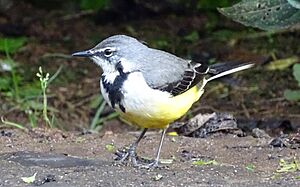Madagascar wagtail facts for kids
Quick facts for kids Madagascar wagtail |
|
|---|---|
 |
|
| Andasibe-Mantadia National Park | |
| Conservation status | |
| Scientific classification |
The Madagascar wagtail (Motacilla flaviventris) is a special kind of bird. It is part of the wagtail family. This bird is found only on the island of Madagascar.
Contents
What Does It Look Like?
The Madagascar wagtail is a graceful and slim bird. Its upper parts are grey, and its chest is white. Its belly is a bright yellow. It has a black band across its chest.
Its long tail has a dark center and white feathers on the sides. There is also a short white stripe above its eye. Young birds have a less clear chest band and a fainter stripe above their eyes. This bird is about 19 cm (7.5 inches) long.
Where Do They Live?
The Madagascar wagtail lives only in Madagascar. You can find it all over the island. It is quite common and widespread.
It is most often seen in the eastern parts of the island. It is also common on the central plateau. You might see fewer of them in the north and west. They are rarely found in the very south.
What Is Their Home Like?
Madagascar wagtails usually live near water. This includes rivers, lakes, and even seashores. They also like open areas. You can find them in rice fields and gardens.
They live from sea level up to about 2,500 meters (8,200 feet) high.
What Do They Eat?
The Madagascar wagtail mainly eats small creatures without backbones. These are mostly insects and spiders. It finds its food by walking or running on the ground.
It moves its tail up and down, just like other wagtails. Sometimes, it jumps a few meters into the air. This helps it catch flying prey.
Life Cycle and Family Life
Madagascar wagtails lay their eggs between August and November. They often have two groups of babies in one season. The young birds from the first group sometimes help their parents. They help feed the second group of babies.
Their nest is shaped like a bowl. They build it close to the ground. Nests can be in thick plants, in the fork of a tree branch, or in a crack in a rock. They might even build a nest under the roof of a building. The nest is always near water.



